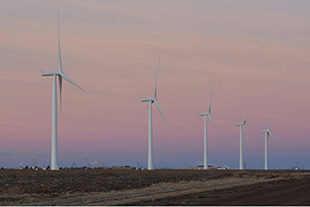Environmental Management System
Department of Energy (DOE) requires sites to maintain an Environmental Management System (EMS) that conforms with the International Organization for Standardization (ISO) 14001. The Pantex EMS has successfully been audited by independent third-party auditors declaring the conformance to the ISO standard.

The Pantex EMS is a significant component of the Pantex Integrated Safety Management System and contributes to sustaining the Pantex imperatives of Safe, Secure, Zero Defects, and Deliver as Promised. The EMS provides a business management system to ensure compliance with environmental regulations, support for the achievement of Department of Energy sustainability goals, and controls are set to accomplish effective waste management, natural and cultural resource management, pollution prevention/source reduction, recycling/reuse, environmental remediation, sustainable acquisition and design principles, energy management/efficiency, fleet management, and water conservation.
A team of Senior Management personnel at Pantex leads the review, approval, promotion, and provision of human and physical resources to support the EMS. This EMS Senior Management Team helps guide achievement of environmental objectives, DOE sustainability goals, continual improvement of the Pantex Plant’s EMS, and conformance with ISO 14001. As leaders, these Team members strive to increase awareness of the Environmental Policy (E-POL-1024) within their organizations across the Plant through communication of our commitments to P2C2:
Protect the environment,
Prevent pollution,
Comply with environmental requirements, and
Continually improve the Plant’s environmental stewardship programs.
The current environmental objectives for FY25 and past EMS objectives are listed below. By utilizing the DOE sustainability goals as our Environmental Aspects, we are in the unique position to work on multiyear objectives on the site and quantify the big projects in terms of environmental impacts. This means that most of the initial objectives for FY2022 with flow into multiple years.
FY25
- Continue to work to upgrade and repair leaking, old infrastructure making the domestic water distribution and the high pressure fire loop systems more efficient.
- Continue the process to repair existing and install new building level electrical meters on covered buildings.
- Energy Independence and Security Act, including audit evaluations and sustainability reporting of the energy conservation measures.
- Continue the five-year plan for additional electric vehicle chargers for the fleet.
- Installation of water bottle filler stations in the two onsite cafeterias and other on-site buildings.
- Environmental Regulatory Compliance target for permit renewal submission of the water quality permit to the Texas Commission on Environmental Quality.
- Revitalize the carpooling program to reduce Greenhouse gases.
- Continue to educate the Plant on recycling and include more recycling options.
- Create a five-year plan for a low-speed vehicle transition to electric.
- Complete external (third-party) Environmental Management System audit.
FY24
- Continue to work to upgrade and repair leaking, old infrastructure making the domestic water distribution and the high pressure fire loop systems more efficient.
- Increase the amount of renewable energy used on-site with construction of the Pantex Wind Farm feeder line to the North substation.
- Energy Independence and Security Act, including audit evaluations and sustainability reporting of the energy conservations measures.
- Continue the process to fix existing energy meters, and install building level energy meters on all covered buildings.
- Continue the installation of electric vehicle chargers for the fleet.
- Installation of water bottle filler stations in the two onsite cafeterias.
- Submit Lead Service Line Inventory to TCEQ by October 2024.
FY23
- Continue to work to upgrade and repair leaking, old infrastructure making the domestic water distribution and the high pressure fire loop systems more efficient.
- Continue the process to install building level water meters on covered buildings.
- Increase the amount of renewable energy used on-site with construction of the Pantex Renewable Energy Project feeder line to the North substation.
- Energy Independence and Sustainability Act, including audit evaluations and sustainability reporting of the energy conservations measures.
- Continue the process to fix existing energy meters, and install building level energy meters on all covered buildings.
- Installation of six electric vehicle chargers for the fleet.
- Installation of water bottle filler stations in the two onsite cafeterias.
FY22
- Continue to work to upgrade and repair leaking, old infrastructure making the domestic water distribution and the high pressure fire loop systems more efficient.
- Begin the process to install building level water meters on covered buildings.
- Increase the amount of renewable energy used on-site with construction of the Pantex Renewable Energy Project feeder line to the North substation.
- Incorporate the new rules from the Energy Act of 2020 into the site’s existing compliance program addressing requirements under the Energy Independence and Sustainability Act, including audit evaluations and sustainability reporting of the energy conservations measures.
- Begin the process to install building level energy meters on covered buildings.
- Installation of electric vehicle chargers for the fleet.
- Determine Plant’s ISO 14001 Compliance – Third Party Audit.
- Installation of water bottle filler stations in the John C, Drummond Center Building and two onsite cafeterias.
